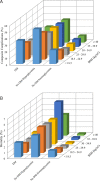Impact of obesity on hospital complications and mortality in hospitalized patients with hyperglycemia and diabetes
- PMID: 27486518
- PMCID: PMC4947725
- DOI: 10.1136/bmjdrc-2016-000200
Impact of obesity on hospital complications and mortality in hospitalized patients with hyperglycemia and diabetes
Abstract
Objective: Obesity is associated with increased risk of diabetes, hypertension and cardiovascular mortality. Several studies have reported increased length of hospital stay and complications; however, there are also reports of obesity having a protective effect on health, a phenomenon coined the 'obesity paradox'. We aimed to investigate the impact of overweight and obesity on complications and mortality in hospitalized patients with hyperglycemia and diabetes.
Research design and methods: This retrospective analysis was conducted on 29 623 patients admitted to two academic hospitals in Atlanta, Georgia, between January 2012 and December 2013. Patients were subdivided by body mass index into underweight (body mass index <18.5 kg/m(2)), normal weight (18.5-24.9 kg/m(2)), overweight (25-29.9 kg/m(2)) and obese (>30 kg/m(2)). Hyperglycemia was defined as a blood glucose >10 mmol/L during hospitalization. Hospital complications included a composite of pneumonia, acute myocardial infarction, respiratory failure, acute kidney injury, bacteremia and death.
Results: A total of 4.2% were underweight, 29.6% had normal weight, 30.2% were overweight, and 36% were obese. 27.2% of patients had diabetes and 72.8% did not have diabetes (of which 75% had hyperglycemia and 25% had normoglycemia during hospitalization). A J-shaped curve with higher rates of complications was observed in underweight patients in all glycemic groups; however, there was no significant difference in the rate of complications among normal weight, overweight, or obese patients, with and without diabetes or hyperglycemia.
Conclusions: Underweight is an independent predictor for hospital complications. In contrast, increasing body mass index was not associated with higher morbidity or mortality, regardless of glycemic status. There was no evidence of an obesity paradox among inpatients with diabetes and hyperglycemia.
Keywords: Hyperglycemia; Obesity; Type 2 Diabetes.
Figures
References
-
- World Health Organization. Obesity and overweight. Secondary obesity and overweight, 2015http://www.who.int/mediacentre/factsheets/fs311/en/ http://www.who.int/mediacentre/factsheets/fs311/en/ (accessed Apr 2016).
LinkOut - more resources
Full Text Sources
Other Literature Sources

